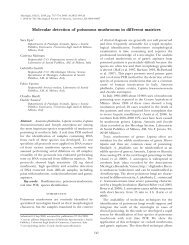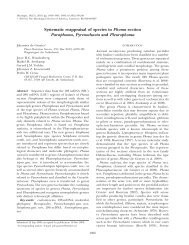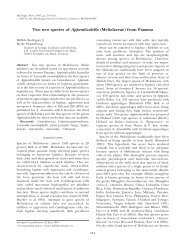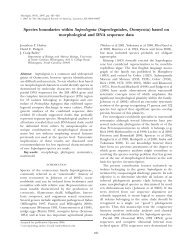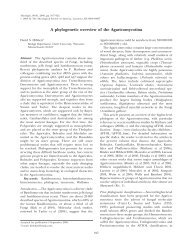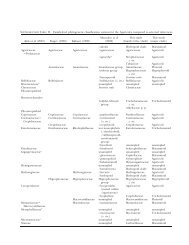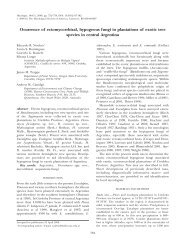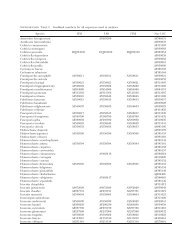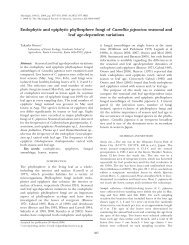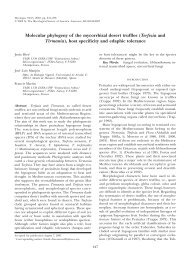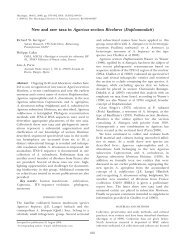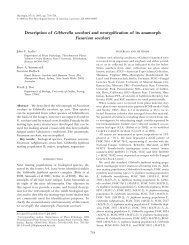A Glomerella species phylogenetically related to ... - Mycologia
A Glomerella species phylogenetically related to ... - Mycologia
A Glomerella species phylogenetically related to ... - Mycologia
Create successful ePaper yourself
Turn your PDF publications into a flip-book with our unique Google optimized e-Paper software.
<strong>Mycologia</strong>, 100(5), 2008, pp. 710–715. DOI: 10.3852/07-192<br />
# 2008 by The Mycological Society of America, Lawrence, KS 66044-8897<br />
A <strong>Glomerella</strong> <strong>species</strong> <strong>phylogenetically</strong> <strong>related</strong> <strong>to</strong> Colle<strong>to</strong>trichum acutatum on<br />
Norway maple in Massachusetts<br />
Katherine F. LoBuglio 1<br />
Donald H. Pfister<br />
Harvard University Herbaria, Cambridge, Massachusetts<br />
02138<br />
Abstract: A fungus isolated from Norway maple<br />
(Acer platanoides) in the Bos<strong>to</strong>n, Massachusetts, area<br />
was determined <strong>to</strong> be a <strong>species</strong> of <strong>Glomerella</strong>, the<br />
teleomorph of Colle<strong>to</strong>trichum acutatum. Pure cultures<br />
of the fungus were obtained from discharged<br />
ascospores from perithecia in leaf tissue. This fungus<br />
was determined <strong>to</strong> be homothallic based on the<br />
observation of perithecial development in cultures of<br />
single-spore isolates grown on minimal salts media<br />
and with sterile <strong>to</strong>othpicks. A morphological and<br />
molecular analysis was conducted <strong>to</strong> determine the<br />
taxonomic position of this fungus. Parsimony analyses<br />
of a combined nucleotide dataset of the ITS and LSU<br />
rDNA region, and of the D1–D2 LSU rDNA region,<br />
indicated that this <strong>species</strong> has phylogenetic affinities<br />
with Colle<strong>to</strong>trichum acutatum, C. acutatum f. sp.<br />
pineum, C. lupini, C. phormii and G. miyabeana.<br />
These results are significant because C. acutatum has<br />
not been reported on Acer platanoides. In addition<br />
the consistent presence of perithecia on leaf tissue<br />
and in culture is unusual for Colle<strong>to</strong>trichum, suggesting<br />
that the teleomorphic state is important in the life<br />
cycle of this fungus.<br />
Key words: Acer, anamorph, Ascomycota,<br />
phylogeny, ribosomal DNA, teleomorph<br />
INTRODUCTION<br />
During fall 2006 leaves of Norway maple (Acer<br />
platanoides) in the Bos<strong>to</strong>n area exhibited symp<strong>to</strong>ms<br />
of an anthracnose disease. Symp<strong>to</strong>ms included<br />
irregularly shaped, brown, necrotic lesions with<br />
reddish margins. The lesions often were delimited<br />
by veins. From August <strong>to</strong> November perithecia with<br />
mature asci were found in the lesions on leaves still<br />
attached <strong>to</strong> trees and on leaves that had fallen<br />
prematurely. This study was undertaken <strong>to</strong> determine<br />
the identity and phylogenetic relationships of the<br />
fungus associated with the lesions as well as the<br />
mating system of the fungus.<br />
Accepted for publication 16 May 2008.<br />
1 Corresponding author. E-mail: klobuglio@oeb.harvard.ed<br />
710<br />
MATERIALS AND METHODS<br />
Isolation.—Symp<strong>to</strong>matic leaves were collected from A.<br />
platanoides trees Aug–Nov 2006 (FIG. 1a). Leaves were<br />
examined under a dissecting microscope (FIG. 1a) for the<br />
presence of perithecia (FIG. 1b). Petri plates containing<br />
malt-yeast-extract agar (MEYE, 3.0 g yeast extract, 3.0 g malt<br />
extract, 5.0 g pep<strong>to</strong>ne, 10.0 g glucose and 1 L H20)<br />
medium were inverted over leaves with perithecia. Discharged<br />
ascospores were observed on the agar medium with<br />
a dissecting microscope within 1 h and transferred <strong>to</strong> fresh<br />
medium. Cultures were incubated at room temperature<br />
(approximately 23 C) and ambient light. Cultures also were<br />
established by placing surface-sterilized, symp<strong>to</strong>matic leaf<br />
pieces on MEYE media and incubating them under the<br />
conditions above. Colony morphology was observed from<br />
cultures grown on pota<strong>to</strong>-dextrose agar (PDA, Difco, Bec<strong>to</strong>n<br />
Dickinson & Co., Sparks, Maryland) incubated at 23 C in<br />
the dark as well as at room temperature with ambient light.<br />
Development and morphology of appressoria was observed<br />
examining the underside of glass cover slips that had<br />
been placed on the margin of developing cultures from<br />
which a block of agar had been removed.<br />
Single-spore isolation.—To determine the compatibility systemofthisfungussingle-sporeisolateswereestablishedfrom<br />
ascospores produced in cultures obtained from maple leaf<br />
tissue. Mature perithecia were removed from a culture and<br />
placed on the inside surface of a Petri plate lid. The Petri plate<br />
was turned upside down so that the perithecia would discharge<br />
spores upward on<strong>to</strong> the surface of water agar. Isolated<br />
perithecia also were placed in Petri plates, crushed and<br />
flooded with sterile water. The water with ascospores was<br />
spread on the surface of water agar. Petri plates were examined<br />
with a compound microscope for germinating ascospores that<br />
were not in contact with other spores. Individual germinating<br />
ascospores were transferred <strong>to</strong> the surface of PDA, incubated<br />
at 23 C with constant light from a 10-watt fluorescent bulb and<br />
examined every other day for growth.<br />
Thirty-three single-spore isolates obtained as described<br />
above were grown on PDA and on a minimal salts medium<br />
with au<strong>to</strong>claved flat <strong>to</strong>othpicks on the agar surface (Guerber<br />
and Correll 2001). Inoculum on the minimal salts medium<br />
was placed close <strong>to</strong> the <strong>to</strong>othpicks, which provide a surface<br />
for perithecial development (Guerber and Correll 2001).<br />
These cultures were grown at 23 C under constant light<br />
provided by a 10-watt fluorescent bulb and were examined<br />
every other day for perithecial development.<br />
DNA isolation, amplification and sequencing.—Three of the<br />
five original A. platanoides isolates were selected for DNA<br />
isolation. The isolates were grown on sterile dialysis<br />
membrane (Bel-Art Products, Pequannock, New Jersey,<br />
No. 402990000) placed on the surface of PDA. Mycelium<br />
(equivalent <strong>to</strong> a volume of 250 mL) from each isolate was
LOBUGLIO AND PFISTER: GLOMERELLA AND COLLETOTRICHUM ACUTATUM 711<br />
FIG. 1. <strong>Glomerella</strong> sp. on Acer platanoides. A. Irregularly shaped lesions on leaf of Acer platanoides. B. Close-up of perithecia<br />
observed on lesions. Bar 5 200 mm.<br />
scraped from the membrane in<strong>to</strong> a 1.5 mL Eppendorf tube.<br />
The mycelium was ground with pestles (Kontes Glass Co.,<br />
Vineland, New Jersey, No. 749521-1590) and sterile sand. A<br />
<strong>to</strong>tal of 500 mL of SDS lysis buffer (1% SDS; 200 mMTris,<br />
pH 7.5; 250 mM NaCL; 25 mM EDTA) was added next,<br />
followed by additional grinding. The three samples were<br />
incubated at 70 C on a heating block with occasional<br />
grinding. This solution was extracted with phenol-chloroform<br />
and precipitated as described in Lee et al (1988). A 1/<br />
100 dilution of the DNA was used for PCR amplification of<br />
the ITS and LSU rDNA regions. These rDNA regions were<br />
amplified with rDNA primers ITS1 and ITS4 (White et al<br />
1990) and LROR and LR5 (Moncalvo et al 2000). PCR<br />
amplification, purification and sequencing were carried out<br />
as described in Hansen et al (2005).<br />
Sequence analyses.—The program Sequencher 4.6 (Gene-<br />
Codes, Ann Arbor, Michigan) was used <strong>to</strong> edit nucleotide<br />
sequences. Comparison of <strong>Glomerella</strong> sequences <strong>to</strong> Colle<strong>to</strong>trichum<br />
<strong>species</strong> was done with the program Se-Al v 2.0a8<br />
(Rambaut 1996). A <strong>to</strong>tal of 44 Colle<strong>to</strong>trichum sequences were<br />
compared in this analysis, 42 of which were provided by<br />
M.C. Aime (now at Louisiana State University) from a<br />
recent study of this genus (Farr et al 2006). Plec<strong>to</strong>sphaerella<br />
cucumerina was chosen as the outgroup (Farr et al 2006).<br />
Maximum parsimony analysis of the ITS-LSU combined<br />
dataset was performed with PAUP 4.0b10 (Swofford 2002).<br />
Heuristic searches consisted of 1000 random sequence<br />
addition replicates with tree bisection-reconnection branch<br />
swapping. The strength of the internal branches from the<br />
resulting trees was tested statistically by bootstrap analysis<br />
from 500 bootstrap replications.<br />
The relationship of this fungus from maple <strong>to</strong> two <strong>species</strong><br />
known <strong>to</strong> infect other tree hosts, C. acutatum f. sp. pineum<br />
and G. miyabeana, was examined by phylogenetic analysis of<br />
the D1–D2 LSU region (209 nucleotides) of taxa used in the<br />
present study and the D1–D2 LSU sequences of C. acutatum<br />
subgroups A, B and C, C. acutatum f. sp. pineum and G.<br />
miyabeana (EMBL No. U79691–U79700 and U79710–<br />
U79713, Johns<strong>to</strong>n and Jones 1997).<br />
RESULTS<br />
Morphology and compatibility.—Five isolates (MP1–<br />
MP5) were established from either ascospores or leaf<br />
tissue. Colonies were initially white, becoming gray,<br />
green/gray, or dark gray, initially in the center but<br />
then coloring throughout. Some isolates were slightly<br />
salmon on the upper and lower surface, each with a<br />
distinct white margin. Other cultures remained<br />
white/cream <strong>to</strong> gray with or without a dark center,<br />
and some became dark olive green as viewed from the<br />
<strong>to</strong>p or the under surface. Dense, elevated, aerial<br />
mycelium was characteristic of the colonies, the<br />
center often appearing green/gray velvety. Colony<br />
growth was respectively 4.5–7.8 cm diam after 5 and<br />
14 d on PDA in the dark at 23 C. Dark structures,<br />
which resembled perithecia but did not produce asci,<br />
often were observed throughout.<br />
Limited production of conidia was observed after<br />
1 mo at room temperature under ambient light.<br />
Conidia also formed in orange gelatinous masses<br />
throughout cultures more than 1 mo old. Conidia<br />
were hyaline, aseptate, narrow <strong>to</strong> broadly oblong,<br />
straight <strong>to</strong> irregular in outline, with one end tapered.<br />
Conidia were 10–25 3 3–7 mm. Perithecia were<br />
produced regularly in MEYE and were single or<br />
clustered and superficially embedded in the mycelium<br />
(FIG. 2a). Mature ascospores were variable at<br />
14.4–20 3 4–6.8 mm (FIG. 2b, c). Ascospores were<br />
hyaline, aseptate, narrowly <strong>to</strong> broadly oblong and<br />
straight <strong>to</strong> slightly curved.
712 MYCOLOGIA<br />
FIG. 2. <strong>Glomerella</strong> sp. from Acer platanoides. A. Longitudinal section of perithecia with asci. Bar 5 50 mm. B. Ascus showing<br />
spore arrangement (lac<strong>to</strong>phenol cot<strong>to</strong>n blue). Bar 5 20 mm. C. Young ascus. Bar 5 20 mm. D. Appressoria produced in slide<br />
culture. Bar 5 10 mm.<br />
Appressoria were observed on the underside of<br />
sterile covers slips arising from vegetative hyphae<br />
(FIG. 2d). They were smooth, simple, obovate <strong>to</strong><br />
clavate (instead of lobed and/or in chains) and<br />
varied from light <strong>to</strong> dark brown.<br />
In all single-spore cultures perithecia containing<br />
asci with ascospores were observed after 1 wk on<br />
inoculum plugs and on <strong>to</strong>othpicks on minimal salts<br />
medium. This observation suggests that this fungus is<br />
homothallic. Perithecia were not observed in cultures<br />
grown on PDA under the same conditions.<br />
Phylogenetic analysis.—The ITS and LSU DNA sequences<br />
obtained for the three isolates (MP1, MP2<br />
and MP3) were identical for both rDNA regions. The<br />
ITS-LSU dataset included 1273 nucleotide characters<br />
of which 87 were excluded due <strong>to</strong> questionable<br />
alignment. Of the remaining characters 974 were<br />
constant, 114 of the variable characters were parsimony<br />
uninformative and 98 were parsimony informative.<br />
The strict consensus of 328 488 equally parsimonious<br />
trees (tree length 369, CI 5 0.65 and RI 5 0.83)<br />
is provided (FIG. 3). Bootstrap values are included on<br />
branches. Our analyses showed that the fungus on<br />
maple is <strong>related</strong> <strong>phylogenetically</strong> <strong>to</strong> Colle<strong>to</strong>trichum<br />
<strong>species</strong> in the clade comprising Colle<strong>to</strong>trichum acutatum,<br />
C. lupini and C. phormii with 100% bootstrap<br />
support (FIG. 3). Phylogenetic resolution within this<br />
clade was not achieved due <strong>to</strong> the high sequence<br />
similarity among members of this group.<br />
Phylogenetic analysis of the D1–D2 LSU rDNA<br />
region placed the fungus from maple in the C.<br />
acutatum clade, which included C. acutatum f. sp.<br />
pineum and G. miyabeana with 92% bootstrap support<br />
(1000 bootstrap replications, data not shown). Phylogenetic<br />
relationships within this clade were not<br />
resolved due <strong>to</strong> the high sequence similarity among<br />
isolates (98–100% similarity).<br />
DISCUSSION<br />
Molecular analyses indicated that the <strong>Glomerella</strong><br />
<strong>species</strong> on Acer platanoides in the Bos<strong>to</strong>n area is<br />
<strong>phylogenetically</strong> <strong>related</strong> <strong>to</strong> <strong>species</strong> in the C. acutatum<br />
clade, which include C. acutatum, C. lupini, C.<br />
phormii (FIG. 3), C. acutatum f. sp. pineum and G.<br />
miyabeana. <strong>Glomerella</strong> miyabeana is a pathogen of<br />
willow and was found <strong>to</strong> be <strong>related</strong> <strong>phylogenetically</strong> <strong>to</strong><br />
C. acutatum by Johns<strong>to</strong>n and Jones (1997) using the<br />
D1–D2 LSU rDNA region. Colle<strong>to</strong>trichum acutatum<br />
has not been reported on A. platanoides, <strong>to</strong> our<br />
knowledge. Stipes and Clement (1978) reported an<br />
anthracnose on Acer platanoides in Virginia caused by<br />
<strong>Glomerella</strong> cingulata, which is considered a causal<br />
agent of anthracnose leaf spot on maple <strong>species</strong><br />
(Sinclair and Lyons 2005). We could not find<br />
reference <strong>to</strong> G. acutata or C. acutatum as a pathogen<br />
of Acer platanoides, however C. acutatum has been<br />
reported <strong>to</strong> cause a disease of Japanese maple (Acer<br />
palmatum) in Connecticut (Smith 1993). Smith<br />
(1993) noted that perithecia never were observed<br />
on diseased plant material or in isolates from<br />
Japanese maple leaves grown either alone or in<br />
paired combinations.<br />
Some of the morphological characters in culture of<br />
the <strong>Glomerella</strong> from Norway maple are similar <strong>to</strong> those<br />
of C. acutatum. For example the dark structures<br />
resembling perithecia that often were observed
LOBUGLIO AND PFISTER: GLOMERELLA AND COLLETOTRICHUM ACUTATUM 713<br />
FIG. 3. Strict Consensus of 328 488 equally parsimonious trees based on 1186 nucleotide characters from combined ITS<br />
and LSU DNA sequences (tree length 369, CI 5 0.65 and RI 5 0.83). Values from 500 bootstrap replications are shown above<br />
tree branches. Asterisk indicates the type culture of Colle<strong>to</strong>trichum acutatum. Numbers after scientific names are GenBank.<br />
throughout cultures also were observed for C.<br />
acutatum Group D as has been described by Lardner<br />
et al (1999). In addition few conidia were produced in<br />
culture. Production of conidia by C. acutatum has<br />
been shown <strong>to</strong> vary significantly among isolates, and<br />
loss of the ability <strong>to</strong> produce conidia in culture is not<br />
uncommon (Fernando et al 2000, Du et al 2005).<br />
Conidia were 10–25 3 3–7 mm, which is longer than<br />
those reported by Simmonds (1965) in the original<br />
description of C. acutatum (8.3–14.4 3 2.5–4.0 mm)<br />
but overlaps with the morphological subgroups of C.<br />
acutatum described by Lardner et al (1999) and with
714 MYCOLOGIA<br />
C. phormii, C. acutatum f. sp. pineum and G.<br />
miyabeana (Farr et al 2006, Lardner et al 1999).<br />
Many of the characters of this <strong>Glomerella</strong> differ from<br />
those of C. acutatum. These isolates lack the intense<br />
red pigment described for some isolates of C.<br />
acutatum (Simmonds 1965, Sut<strong>to</strong>n 1992, Lardner et<br />
al 1999, Du et al 2005). Concentric rings, described in<br />
cultures for some isolates of C. acutatum (Lardner et<br />
al 1999, Du et al 2005) were not observed. Ascospores<br />
of the <strong>Glomerella</strong> from Norway maple were 14.4–20 3<br />
4–6.8 mm. This is longer than G. acutata ascospores<br />
reported from highbush blueberry (10.0–16.3 3 4.3–<br />
5.5 mm) by Talgø et al (2007) and from the<br />
teleomorphs established in labora<strong>to</strong>ry crosses by<br />
Guerber and Corell (2001) (12.2–17.7 3 5.0–6.5 mm).<br />
The teleomorph generally is considered <strong>to</strong> have a<br />
minor role in the life his<strong>to</strong>ry of C. acutatum,<br />
occurring rarely if at all in nature (Bryson et al<br />
1992, Peres et al 2005). C. acutatum typically<br />
predominates on its host in the anamorphic state<br />
producing acervuli with abundant conidia during the<br />
growing season, which are dispersed by water (Peres<br />
et al 2005, Sinclair and Lyons 2005). In the present<br />
study the teleomorph was the dominant state in the<br />
life cycle both in vivo and in vitro.<br />
Guerber and Correll (2001) were the first <strong>to</strong><br />
observe the teleomorph of C. acutatum, <strong>Glomerella</strong><br />
acutata, from labora<strong>to</strong>ry crosses of single-spore<br />
isolates. <strong>Glomerella</strong> acutata has been detected for the<br />
first time in nature on fruits from highbush blueberry<br />
(Vaccinium corymbosum) (Talgø et al 2007). The<br />
phylogenetic placement of the <strong>Glomerella</strong> from maple<br />
in the Colle<strong>to</strong>trichum acutatum clade, which includes<br />
other <strong>Glomerella</strong> <strong>species</strong> capable of producing perithecia<br />
in nature, suggests that the sexual state might<br />
have a larger role in the life his<strong>to</strong>ry of this group than<br />
previously considered.<br />
The fungus in this study was widespread in 2006 in<br />
eastern Massachusetts on Norway maple leaves exhibiting<br />
early defoliation in 2006. We found no evidence<br />
of this fungus on Norway maple leaves in 2007. The<br />
significantly less precipitation in Massachusetts during<br />
summer and fall 2007 compared <strong>to</strong> 2006 (www.<br />
bluehill.org) might account for the absence of this<br />
fungus on Norway maple leaves in 2007. Nonetheless<br />
no collections of this fungus could be located in the<br />
Farlow Herbarium, which house many specimens<br />
collected locally over the past 150 y.<br />
ACKNOWLEDGMENTS<br />
We thank Amy Y. Rossman, James C. Correll and an<br />
anonymous reviewer for helpful comments on this manuscript.<br />
LITERATURE CITED<br />
Bryson RJ, Caten CE, Hollomon DW, Bailey JA. 1992.<br />
Sexuality and genetics of Colle<strong>to</strong>trichum. In: Bailey JA,<br />
Jeger MJ, eds. Colle<strong>to</strong>trichum. Biology, pathology and<br />
control. Wallingford, UK: CAB International. p 27–46.<br />
Du M, Schardl CL, Nuckles EM, Vaillancourt LJ. 2005.<br />
Using mating-type gene sequences for improved<br />
phylogenetic resolution of Colle<strong>to</strong>trichum <strong>species</strong> complexes.<br />
<strong>Mycologia</strong> 97:641–658.<br />
Farr DF, Aime MC, Rossman AY, Palm ME. 2006. Species of<br />
Colle<strong>to</strong>trichum on Agavaceae. Mycol Res 110:1395–1408.<br />
Fernando THP, Jayasinghe CK, Wijesundera RLC. 2000.<br />
Fac<strong>to</strong>rs affecting spore production, germination and<br />
viability of Colle<strong>to</strong>trichum acutatum isolates from Hevea<br />
brasiliensis. Mycol Res 104:681–685.<br />
Guerber JC, Correll JC. 2001. Characterization of <strong>Glomerella</strong><br />
acutata, the teleomorph of Colle<strong>to</strong>trichum acutatum.<br />
<strong>Mycologia</strong> 93:216–229.<br />
Hansen K, LoBuglio KL, Pfister DH. 2005. Evolutionary<br />
relationships of the cup-fungus genus Peziza and<br />
Pezizaceae inferred from multiple nuclear genes:<br />
RPB2, b-tublin and LSU rDNA. Mol Phylogenet Evol<br />
36:1–23.<br />
Johns<strong>to</strong>n PR, Jones D. 1997. Relationships among Colle<strong>to</strong>trichum<br />
isolates from fruit-rots assessed using rDNA<br />
sequences. <strong>Mycologia</strong> 89:420–430.<br />
Lardner R, Johns<strong>to</strong>n PR, Plummer KM, Pearson MN. 1999.<br />
Morphological and molecular analysis of Colle<strong>to</strong>trichum<br />
acutatum sensu la<strong>to</strong>. Mycol Res 103:275–285.<br />
Lee SB, Milgroom MG, Taylor JW. 1988. A rapid high yield<br />
mini-prep method for isolation of <strong>to</strong>tal genomic DNA<br />
from fungi. Fungal Genet Newslett 35:23–24.<br />
Moncalvo J-M, Lutzoni FM, Rehner SA, Johnson J, Vilgalys<br />
R. 2000. Phylogenetic relationships of agaric fungi<br />
based on nuclear large subunit ribosomal DNA<br />
sequences. Sys Biol 49:278–305.<br />
Peres NA, Timmer LW, Adaskaveg JE, Correll JC. 2005.<br />
Lifestyles of Colle<strong>to</strong>trichum acutatum. Plant Dis 89:784–<br />
796.<br />
Rambaut A. 1996. Se-Al. Sequence alignment edi<strong>to</strong>r.<br />
Version 1.0 alpha. Oxford, UK: Univ Oxford. http://<br />
evolve.zoo.ox.ac.uk/Se-Al/Se-Al.html<br />
Simmonds JH. 1965. A study of the <strong>species</strong> of Colle<strong>to</strong>trichum<br />
causing ripe fruit rots in Queensland. Queensland J Ag<br />
Sc 22:437–459.<br />
Sinclair WA, Lyons HH. 2005. Diseases of trees and shrubs.<br />
2nd ed. Ithaca, New York: Cornell Univ Press. 110 p.<br />
Smith VL. 1993. Canker of Japanese maple caused by<br />
Colle<strong>to</strong>trichum acutatum. Plant Dis 77:197–198.<br />
Stipes RJ, Clement GL. 1978. Anthracnose of Acer<br />
platanoides in Virginia. Virginia J Sc 29:76.<br />
Sut<strong>to</strong>n BC. 1992. The genus <strong>Glomerella</strong> and its anamorph<br />
Colle<strong>to</strong>trichum. In: Bailey JA, Jeger MJ, eds. Colle<strong>to</strong>trichum.<br />
Biology, pathology and control. Wallingford, UK:<br />
CAB International. p 1–26.<br />
Swofford DL. 2002. PAUP*: phylogenetic analysis using<br />
parsimony (*and other methods). Version 4. Sunderland,<br />
Massachusetts: Sinauer Associates.<br />
Talgø V, Aamot HU, Stromeng GM, Klemsdal SS, Stensvand
LOBUGLIO AND PFISTER: GLOMERELLA AND COLLETOTRICHUM ACUTATUM 715<br />
A. 2007. <strong>Glomerella</strong> acutata on Highbush Blueberry<br />
(Vaccinium corymosum L.) in Norway. Plant Health<br />
Prog. DOI: 10.1094/PHP-2007-0509-01-RS.<br />
White T, Bruns T, Lee S, Taylor J. 1990. Amplification and<br />
direct sequencing of fungal ribosomal RNA genes for<br />
phylogenetics. In: Innis MA, Gelfand DH, Sninsky JJ,<br />
White TJ, eds. PCR pro<strong>to</strong>cols: a guide <strong>to</strong> methods and<br />
applications. San Diego: Academic Press. p 315–322.



